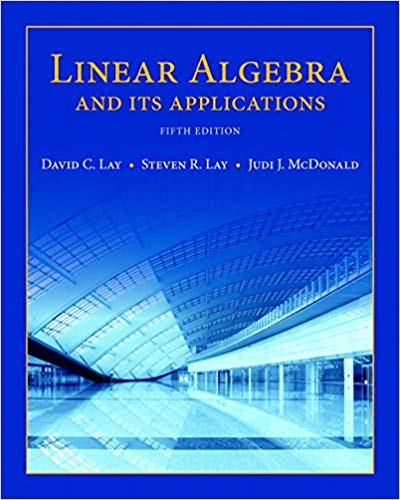
Linear Algebra and Its Applications, 5th Edition
Authors: David C. Lay, Steven R. Lay, Judi J. McDonald
ISBN-13: 978-0321982384
We have solutions for your book!
See our solution for Question 5E from Chapter 2.8 from Lay's Linear Algebra and Its Applications, 5th Edition.
Problem 5E
Chapter:
Problem:
Determine if w is in the subspace of...
Step-by-Step Solution
Step 1
We vectors:\[{v_1} = \left[ {\begin{array}{*{20}{c}}2\\3\\{ - 5}\end{array}} \right],{v_2} = \left[ {\begin{array}{*{20}{c}}{ - 4}\\{ - 5}\\8\end{array}} \right]{\rm{ and }}w = \left[ {\begin{array}{*{20}{c}}8\\2\\{ - 9}\end{array}} \right]\]We have to determine whether the vector $w$ is in the subspace of vectors spanned by $v_1$ and $v_2$. To prove that, we will try to prove that the vector equations given by, $\left[ {\begin{array}{*{20}{l}}{{v_1}}&{{v_2}}&w\end{array}} \right]$ has a consistent solution. If the system is inconsistent, the $w$ is not in the subspace.
Step 2: The Augmented Matrix Form
\[\begin{array}{l}\left[ {\begin{array}{*{20}{l}}{{v_1}}&{{v_2}}&w\end{array}} \right] = \left[ {\begin{array}{*{20}{c}}2&{ - 4}&8\\3&{ - 5}&2\\{ - 5}&8&{ - 9}\end{array}} \right]\\\\M = \left[ {\begin{array}{*{20}{c}}2&{ - 4}&8\\3&{ - 5}&2\\{ - 5}&8&{ - 9}\end{array}} \right]\end{array}\]
Step 3: Row reduce the augmented matrix
\[\begin{array}{l}M = \left[ {\begin{array}{*{20}{c}}2&{ - 4}&8\\3&{ - 5}&2\\{ - 5}&8&{ - 9}\end{array}} \right]\\\\\left[ {\begin{array}{*{20}{c}}2&{ - 4}&8\\0&1&{ - 10}\\0&{ - 2}&{11}\end{array}} \right]{\rm{ ::}}\,\,{R_2} \to {R_2} - \frac{3}{2}{R_1};\,\,{R_3} \to {R_3} + \frac{5}{2}{R_1}\\\\\left[ {\begin{array}{*{20}{c}}2&{ - 4}&8\\0&1&{ - 10}\\0&0&{ - 9}\end{array}} \right]{\rm{ ::}}\,{\rm{ }}{R_3} \to {R_3} + 2{R_2}\end{array}\]From the last row we have: \[0 = - 9\]This is not True, hence the system of equations is not consistent. Hence the vector $w$ is not in the subspace spanned by vectors $v_1$ and $v_2$
ANSWER
$w$ is not in the subspace spanned by vectors $v_1$ and $v_2$
We vectors:\[{v_1} = \left[ {\begin{array}{*{20}{c}}2\\3\\{ - 5}\end{array}} \right],{v_2} = \left[ {\begin{array}{*{20}{c}}{ - 4}\\{ - 5}\\8\end{array}} \right]{\rm{ and }}w = \left[ {\begin{array}{*{20}{c}}8\\2\\{ - 9}\end{array}} \right]\]We have to determine whether the vector $w$ is in the subspace of vectors spanned by $v_1$ and $v_2$. To prove that, we will try to prove that the vector equations given by, $\left[ {\begin{array}{*{20}{l}}{{v_1}}&{{v_2}}&w\end{array}} \right]$ has a consistent solution. If the system is inconsistent, the $w$ is not in the subspace.
Step 2: The Augmented Matrix Form
\[\begin{array}{l}\left[ {\begin{array}{*{20}{l}}{{v_1}}&{{v_2}}&w\end{array}} \right] = \left[ {\begin{array}{*{20}{c}}2&{ - 4}&8\\3&{ - 5}&2\\{ - 5}&8&{ - 9}\end{array}} \right]\\\\M = \left[ {\begin{array}{*{20}{c}}2&{ - 4}&8\\3&{ - 5}&2\\{ - 5}&8&{ - 9}\end{array}} \right]\end{array}\]
Step 3: Row reduce the augmented matrix
\[\begin{array}{l}M = \left[ {\begin{array}{*{20}{c}}2&{ - 4}&8\\3&{ - 5}&2\\{ - 5}&8&{ - 9}\end{array}} \right]\\\\\left[ {\begin{array}{*{20}{c}}2&{ - 4}&8\\0&1&{ - 10}\\0&{ - 2}&{11}\end{array}} \right]{\rm{ ::}}\,\,{R_2} \to {R_2} - \frac{3}{2}{R_1};\,\,{R_3} \to {R_3} + \frac{5}{2}{R_1}\\\\\left[ {\begin{array}{*{20}{c}}2&{ - 4}&8\\0&1&{ - 10}\\0&0&{ - 9}\end{array}} \right]{\rm{ ::}}\,{\rm{ }}{R_3} \to {R_3} + 2{R_2}\end{array}\]From the last row we have: \[0 = - 9\]This is not True, hence the system of equations is not consistent. Hence the vector $w$ is not in the subspace spanned by vectors $v_1$ and $v_2$
ANSWER
$w$ is not in the subspace spanned by vectors $v_1$ and $v_2$